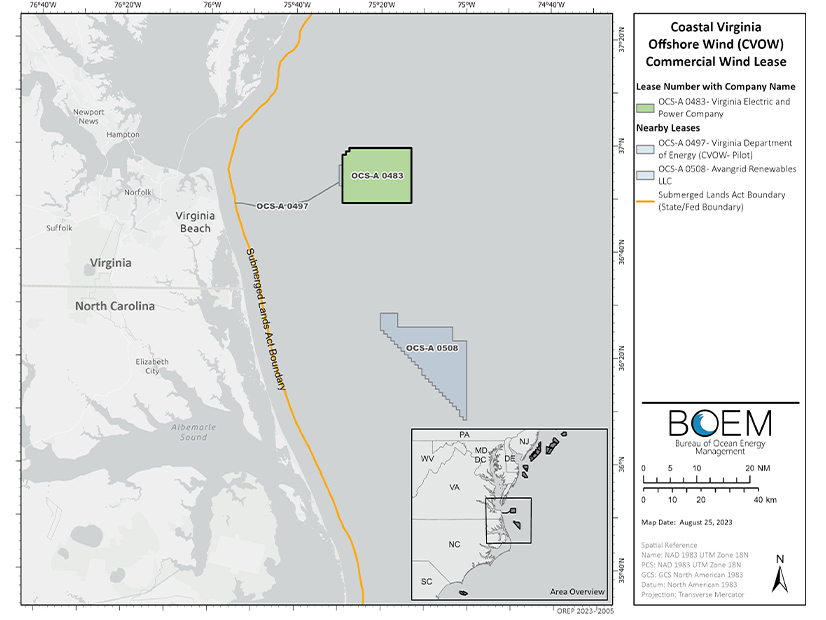Federal regulators on Monday published the final environmental impact statement for Coastal Virginia Offshore Wind, setting the stage for approval of the largest wind farm yet in U.S. waters.
Dominion Energy proposes to erect 176 wind turbines and three substations in a 112,800-acre lease area 27 miles off the Virginia coast.
In its environmental report, the U.S. Bureau of Ocean Energy Management said CVOW could have major adverse effects on the fishing industry, the North Atlantic right whale, vessel navigation, onshore wetlands, and search and rescue operations.
Monday’s report is the fourth final environmental impact statement BOEM has published this year. Completion of the study typically is followed in fairly short order by a Record of Decision — the last major hurdle in the federal regulatory process.
All four Records of Decision issued so far have been approvals.
The final environmental report was published this month for Empire Wind, putting it in line to be the fifth major offshore wind project green-lighted in U.S. waters. Unless CVOW jumps ahead, it would be sixth.
The CVOW environmental impact statement specifies a project with up to 202 turbines and up to 3,000 MW nameplate capacity. A Dominion news release Monday specified a 2,587-MW project, which would be larger than the five wind farms ahead of it in the federal review process.
The CVOW environmental impact statement differs from some of the others in that it does not list cumulative impacts.
The first two utility-scale offshore projects to start construction, Vineyard and South Fork, are part of a tight cluster of lease areas off the New England coast; the New York Bight contains another grouping of lease areas. Such concentrations of projects create potential for a collective impact beyond whatever individual impact a given project might have.
But CVOW still has few potential neighbors at this stage in the U.S. push to develop an offshore wind sector.
As with the other projects’ environmental impact statements, the potential effects of CVOW are presented as a range of possibilities — some of them positive, some negative, some either.
The net impact on air quality, for example, is predicted to be minor but could be adverse or beneficial. Birds might suffer negligible, minor or moderate adverse effects, or they might see minor beneficial effects.
Even the for-hire recreational fishing industry might see some benefit, if the underwater structures create habitat favorable for the species sport anglers like to catch.
Commercial fishing, however, potentially faces a double negative — changes in the number or behavior of species that are valuable for food and constraints on catching them near underwater infrastructure.
Dominion welcomed the environmental impact statement in a news release Monday, saying it reflects feedback from stakeholders.
CEO Bob Blue said: “The completion of CVOW’s environmental review is another significant milestone to keep the project on time and on budget. Regulated offshore wind has many benefits for our customers and local economies — it’s fuel free, emissions free and diversifies our fuel mix to maintain the reliability of the grid. Today’s announcement reinforces the confidence that the company, our vendors and our suppliers have in our project’s completion, providing further motivation to maintain focus on delivering on time and on budget knowing we and our government partners continue to meet critical milestones.”
The company said more than 750 people in Virginia are working on the project directly or in a supporting role.
The Business Network for Offshore Wind said approval of CVOW would bring the pipeline to more than 7 GW. It also supports critical supply chain development as the industry gets started in the U.S., said John Begala, a vice president at the trade organization.
In a news release, Begala said: “Dominion’s CVOW project is anchoring a critical corner of the emerging domestic supply chain, and advancing this project means supporting development of America’s first wind turbine installation vessel, the siting of a blade assembly factory and substantial port redevelopment work. The Hampton Roads area is abuzz with offshore wind activity, and the federal government’s advancement of the CVOW project will continue advancing the area as a hub for the whole industry. The network applauds BOEM for maintaining consistent, timely reviews of COPs while ensuring environmental protection.”



